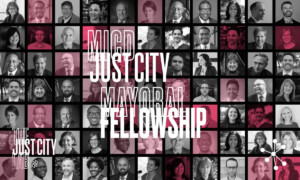How is a public constituted, both spatially and socially? How does the public become legible and desirable? For whom does it exist? These are some of the questions that animate Toni Griffin’s proseminar “Of the Public. In the Public. By the Public” at the Harvard Graduate school of Design (GSD). Toni Griffin, Professor in Practice of Urban Planning at Harvard GSD, specializes in leading complex, transdisciplinary planning, and urban design projects for multi-sector clients in cities with long histories of spatial and social injustice. The proseminar course draws from scholars, practitioners, and urban planners to build foundational intelligence and provocative interpretations of the plural meanings of public.

Griffin is Domain Head for Publics, one of four concentrations in the Master in Design Studies (MDes) at GSD. The program challenges conventional ways of learning and prepares students to understand how design shapes and influences the underlying processes of contemporary life. The program is uniquely situated at the GSD to draw on insights from a multitude of fields and expertise to break down the silos between disciplines and develop a holistic understanding of complex issues. Through fieldwork, fabrication, collaboration, and dissemination, the program is aimed at those who want to develop expertise in design practice while gaining tools to enable a wide range of career paths. Students select one of four domains of study—Ecologies, Narratives, Publics, and Mediums—and undertake a core set of courses, including labs, seminars, workshops, initiatives, publications, and ongoing projects that connect advanced research methods and related topical courses. Uniquely, trajectories within each domain allow students to construct their own interdisciplinary tracks and take part in course offerings across the GSD, as well as other schools and departments at Harvard.
Many of these core concepts resonate with Grffin’s practice. She is founder of urbanAC, based in New York, and leads The Just City Lab, a research platform for developing values-based planning methodologies and tools, including the Just City Index and a framework of indicators and metrics for evaluating public life and urban justice in public plazas.
Harvard GSD’s Joshua Machat spoke with Toni Griffin about the MDes program, open projects, and how the Publics domain set out to explore the socio-spatial design, planning, implementation, and advocacy.
Joshua Machat: Why do you think the Publics domain is of interest to architects who are still in the early parts of their professional careers?
Toni Griffin: They appear to be architects who are no longer satisfied with traditional modes of architecture, which tend to focus on the building and the outcome. They’re more interested in the forces that shape architecture and the built environment. And they’re interested in the impact of that architecture on society, people, and place. Architecture, particularly in its pedagogy in undergraduate and graduate programs—and sometimes even in practice—doesn’t address those issues sufficiently. I’m finding that applicants are looking to round out their understanding of how the built world is produced through architecture and/or other disciplines. Who is involved in that work, who’s impacted in that work, who does that work benefit, and who gets to decide, are all part of their curiosities.
Interdisciplinary and transdisciplinary thinking is a critical part of contemporary problem-solving in design. Can you explain how this approach is integrated into the Publics domain?
I do it perhaps in a couple of ways in the proseminar, which is divided into six modules. “To be Public”, which is about how we bring our individual identities, cultures, and backgrounds into the public realm. “Of the Public”, which is about the data, knowledge, memories, that we place into the public realm. “By the Public”, which is about public governance. “For the Public”, which is about the things that the public sector provides for society, cities, and neighborhoods. “With the Public” is about engagement, participation, and power. “In the Public” is about how creatives and designers place things in the public realm.
We have two guest speakers who come and speak on each of those modules. They tend to come from two disciplinary perspectives: two different disciplines are in dialogue about a particular topic every other week. Secondly, the students are put into teams, and they have to co-facilitate a class where they lead the discussion, not me. This requires them to work together. Because the students come from different backgrounds and experiences—whether different genders, ethnicities, nationalities, or disciplines—they often forge a cross-identity and cross-disciplinary collaboration.
The advance of the just city is at the core of your Publics proseminar. The Mayors Imagining the Just City Symposium was held in April and MICD Fellows discussed strategies for using planning and design interventions to address racial injustice in each of their respective cities. How did this conversation support the Publics proseminar learning objectives?

The Mayors Imagining the Just City public event is a part of the Mayor’s Institute on City Design Just City Mayoral fellowship program, which I lead through the Just City Lab. This is the third year of the fellowship in which eight mayors participate in an eleven-week online curriculum centered on best practices and examples of how urban planning, design, and development—the work that mayors lead—can achieve greater social and spatial justice.
During the closing session, when the mayors come back to Cambridge to present their projects and get feedback from eight resource experts, we end the program with a public program and presentation to give the GSD community exposure and access to city leaders and the roles that they play in building cities in collaboration with practitioners of the disciplines we offer at the GSD.
The learning objective is to create greater understanding around how public government, and specifically mayors, lead and shape this type of work. The event exposes students and the rest of the GSD community to the complexity of decision making around resources, choices, policies, and priorities that are helping to address issues in chronically disinvested neighborhoods and/or populations that have historically been marginalized through racially exclusionary and discriminatory practices.
It’s always my interest to expose students to other modes of practice, like the public sector, and the ways in which architects, landscape architects, and urban planners might find themselves situated in a public sector role—even running for mayor—and the ways in which their expertise can be useful within government, and not always as a consultant to government.
What do you think are the most distinguishing qualities of the MDes degree program at the GSD?
What makes the MDes program so attractive to students, and to me, is that it’s the most entrepreneurial design degree that we offer. Being a part of the program requires students to be comfortable with self-directing their journey through the four semesters. Students’ ability to choose a substantial number of your courses, across the departments at the GSD, across Harvard, and even some at MIT, is just amazing. It parallels how you might do a doctorate. It’s very self-directed. The beauty is in all the choices you get to make to inform your own intellectual curiosity. The challenge of that is all the courses on offer that you just won’t have time to do. It’s an embarrassment of riches and an extraordinary luxury students have that sometimes causes them a little bit of angst. But ultimately, they end up quite satisfied with the volume of choices.
I also like that the program includes students who have been out in the world working for some time alongside some students who are just coming out of their undergrad. I think that world experience, whether it’s two years or fourteen years, adds a lot to the depth of conversation. Students don’t realize that we as teachers are just as engaged in what they bring to the discussion as we give to them; in fact, it is a reciprocal relationship that makes for the best classroom environment.
The GSD is one of the most student-engaged design programs that I’ve ever been a part of. Students are very proactive through clubs, volunteer efforts, the production of their own events, and discussion groups. That brings a unique energy to the school and can drive change within the school. Students have a level of agency that allows them to feel very connected to each other and the GSD community, both during their time in the program and even after as alumni.